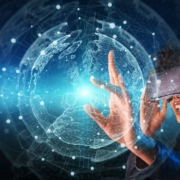Exploring the Industrial Metaverse: A Glimpse into the Future
On June 12, 2023, MIT Technology Review and Siemens co-hosted a two-plus-hour in-person event program entitled, “Enabling the Industrial Metaverse.” TBR attended, and the following perspective reflects the presentations and follow-on one-on-one discussions with Siemens leaders and other event attendees.
What Is the Industrial Metaverse?
Offering users an immersive, real-time experience, the industrial metaverse draws on existing cloud-to-edge technologies to simulate, optimize and simplify complex systems across industries, predominantly manufacturing.
As highlighted by MIT Technology Review, there are multiple sectors of the metaverse, and while consumer and enterprise use cases are still being developed, the industrial use cases are more clearly defined, offering businesses the potential to streamline operations, from accessing new talent to detecting machine errors.
Currently, the state of the industrial metaverse is focused on facilitating speed and allowing businesses to create solutions that have a real-world impact. These impacts, enabled by the industrial metaverse, will continue to be supported by advancements in AI, machine learning, blockchain and IoT technology, alongside a collaborative ecosystem inclusive of hyperscalers, niche ISVs, industry consortiums, IT services vendors and government entities.
Watch Now – The Power of Data in the Cloud: A Deep Dive Into the PaaS Market and Ecosystem
The Future of the Industrial Metaverse Will Be Determined by Collaboration, Openness and Interoperability
As highlighted by Douglas Bellin, head of Business Development, Industry 4.0 and Smart Factory at Amazon Web Services (AWS), the compute, storage and networking requirements of the industrial metaverse are undeniably massive. Of course, scalable cloud-based compute is AWS’ bread and butter, but Bellin candidly recognized that the industrial metaverse will extend well beyond the infrastructure layer.
While relying on that infrastructure, the data layer is what will shape the industrial metaverse and its greatest industry supporter — manufacturing — which, as noted by the panelists, produces the most data of any industry but lags other industries in the consumption and usage of that data.
As such, we note significant room for growth and opportunity for vendors that can help close the gap between data producers and consumers in the manufacturing industry. This largely includes establishing an experiential data layer that not only supports multiple endpoints and user experiences but also, by default, is open and leverages multiple APIs that can improve interoperability (for example, controlling machine-to-machine interfaces).
The metaverse is open by default, but it will only remain that way if vendors continue to expose their APIs and if cloud providers align with industry leaders like Siemens to improve interoperability. To support an open, collaborative industrial metaverse, however, vendors must also better collaborate around governance to define how value will be divided among the owners of data and vendors that have made their APIs publicly available. These actions, which can help streamline the flow of data throughout the industrial metaverse, may be enough to further align both OT and IT stakeholders and help bring the industrial metaverse into the mainstream.
Speed Now, Ecosystems and Supply Chains Later
In a panel discussion with Bellin and Marshall Van Alstyne, a Boston University professor and visiting scholar for the MIT Initiative on the Digital Economy, Siemens Chief Technology Officer Peter Koerte noted that the greatest value coming from the industrial metaverse would be speed — faster solutions to real-world problems, faster insights into what causes problems and faster decision making across the entire enterprise.
As an example, Koerte noted that Siemens believes the industrial metaverse could help engage factory workers — the people most immediately impacted by changes to floor layouts and processes — in the design of the facility from the start.
Koerte saw the most promising near-term benefit of the industrial metaverse in sharing data across supply chains while expressing minimal interest in the potential of AR/VR headsets. Tamping down his fellow panelists’ enthusiasm, Koerte summed up his position — although not necessarily Siemens’ — by suggesting the myriad benefits of the industrial metaverse, particularly across an ecosystem of connected enterprises, will take more time to develop.
In TBR’s view, Koerte presented the most sobering and balanced view of the industrial metaverse, perhaps reflecting his own company’s day-to-day immersion in the intricacies — and very real physicality — of industrial environments. While his fellow panelists noted the massive amounts of data that industrial enterprises generate (Bellin) and the power of recombinant innovation (Van Alstyne), Koerte’s grounded views resonated with TBR and were echoed by the subsequent presentation on the value of applying digital twinning technology to protect and revitalize coral reefs.
During the event’s second panel discussion, Josh Drean, co-founder of the Work3 Institute and a Web3 advisor to the Harvard Innovation Labs, and Kam VedBrat, Microsoft’s head of product for Azure IoT, Azure Digital Twins and Windows IoT, discussed the human implications of the industrial metaverse. Drean expressed optimism for the “rich, human interactions,” and VedBrat predicted digital twins would help overcome the often adversarial challenges inherent in bridging IT and OT.
In TBR’s view, this persistent IT-OT divide provides a massive opportunity for IT services and technology vendors, most likely through ecosystem plays merging the skills and expertise of firms such as Microsoft and its consulting partners. In a year’s time, progress on the industrial metaverse will likely be measured most easily by the narrowed gap between IT and OT practitioners within an industrial enterprise.



 Technology Business Research, Inc.
Technology Business Research, Inc.